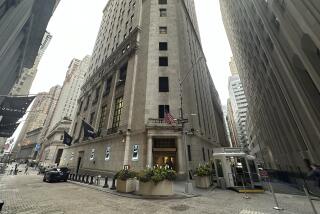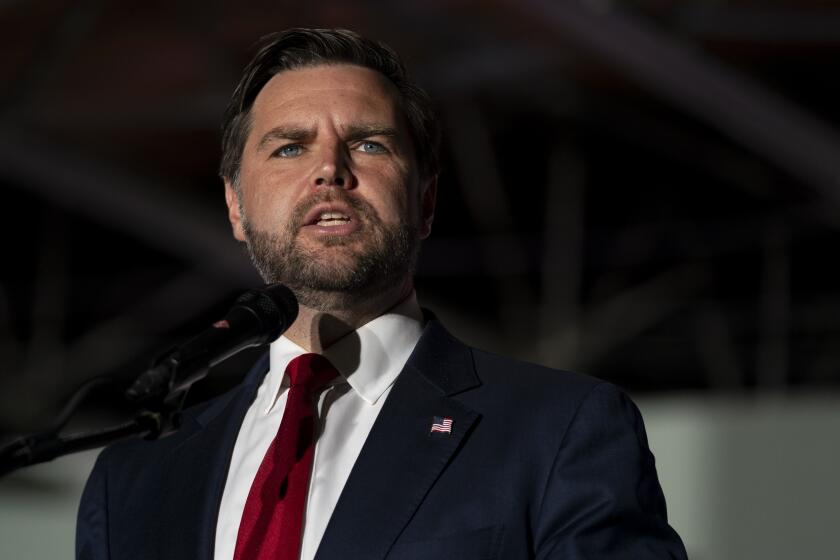Strong Job, Pay Figures Fuel Stock Market Rise
WASHINGTON — The U.S. jobless rate held steady at a 29-year low in November, yet inflation was scarcely to be seen, the Labor Department said Friday, in a double dose of good news that spurred an across-the-board Wall Street rally.
Confirmation that the economy had extended its extraordinary expansion by yet another month sent virtually all categories of stocks soaring and drove the Nasdaq exchange to another record. The Dow Jones industrial average jumped by 247.12 points, or 2.2%, to 11,286.18--within 40 points of its Aug. 25 all-time high.
The government reported that the jobless rate held at 4.1% of the U.S. work force in November, a level not seen since 1970. At the same time, average hourly earnings increased by just 0.1%, down from the 0.3% wage gain posted in October.
In addition, about 234,000 nonfarm jobs were created in November, the department said, slightly more than private economic forecasters had predicted.
“To me, the great wonder is that we are able to find all these bodies, given that we are short of labor from sea to shining sea,” said Sung Won Sohn, chief economist for San Francisco-based Wells Fargo Bank.
Unseasonably warm, dry weather in November appears to have fueled hiring, especially in such outdoor sectors as construction and agriculture. Construction alone added a whopping 41,000 jobs during the month.
The only unexpected weakness in the job market appeared in the relatively low-paying retail sector. There, even with the holiday rush approaching, and with “help wanted” signs in abundance, only 1,000 new jobs were filled. Analysts saw this as a possible worrisome sign, amid the otherwise upbeat news, that a labor shortage may be looming.
“We’re running out of workers to hire, and that’s a good thing, as long as there’s no inflation,” said Diane Swonk, chief economist at BankOne Corp. in Chicago.
She said November’s data on retail jobs reflect anecdotal information she has heard in her area about desperate department stores calling up job applicants, interviewing them on the phone and hiring them sight unseen. Some stores are even promising managerial “careers” to these holiday short-term hires, she said.
The Federal Reserve’s rate-setting Open Market Committee will meet Dec. 21, and while investors have not expected the Fed to move to cool the economy then--the year-end Y2K risks are thought to be too great--Friday’s employment data further reassured them that there would be no immediate need for an interest rate hike.
“The consensus in the markets now is that they can’t do anything in December,” said Maureen F. Allyn, chief economist at Scudder Kemper Investments.
Wells Fargo’s Sohn agreed but said he wouldn’t be surprised to see the Open Market Committee change its current “neutral” bias to one favoring a future rate hike.
“I think there’s a good possibility that [Fed Chairman Alan] Greenspan will want to send a message to the marketplace that [says], ‘Look, I’m worried,’ ” Sohn said.
In addition to the tight labor market and continued strong growth, there is evidence that the Fed has quietly introduced more money into the economy in recent weeks as a buffer against Y2K problems in the financial sector.
“The thing is, what are you going to do when there’s not a Y2K problem?” Allyn said. “Then they’ll have to take some of that liquidity back.” She and other economists are forecasting a rate increase of 0.25% in the spring.
Normally, inflation has appeared in the U.S. economy every time the unemployment rate has dipped to about 6%. At that level in the past, employers began having trouble finding new workers to hire and were compelled to offer pay increases. Then, in turn, they have passed on their increased labor costs to consumers, in the form of higher prices.
For months now, however, that chain appears to have been broken, and economists have been struggling to explain why.
Allyn said she thinks the most important factor holding down price increases at the moment is executive compensation. Increasingly, she said, executives are being granted stock options, and these options are worth more when the company’s stock price goes up. And one of the best ways to make a stock price go up is convincing Wall Street that employee wages are under control.
“They’ll do everything to keep labor costs down,” Allyn said of the option-holding executives.
Similarly, she said, the current tendency to link employee compensation to performance--at all levels, not just in the executive suites--is helping to hold down labor costs.
Wells Fargo’s Sohn added that America’s high levels of immigration now may also help explain the absence of inflation in today’s tight labor markets. Immigrants tend to be either the highly educated or the unskilled, with very few in the middle. And since the vast majority are at the unskilled end of the spectrum, they cannot expect high wages.
More to Read
Inside the business of entertainment
The Wide Shot brings you news, analysis and insights on everything from streaming wars to production — and what it all means for the future.
You may occasionally receive promotional content from the Los Angeles Times.










